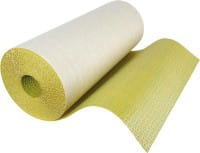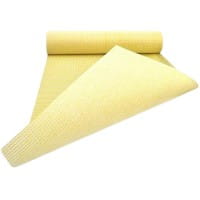Decoupling mats for bridging cracks
What is meant by decoupling mats?

Decoupling mats are used to install flooring on uneven or unstable subfloors by absorbing and reducing subfloor movement. They are usually made of plastic or rubber and have a textured surface to ensure better adhesion of the flooring. The main function of decoupling mats is to protect the flooring from damage that can be caused by movement of the subfloor. For example, if the subfloor is uneven or unstable, this can cause the flooring to warp, crack or break over time. Decoupling mats reduce these movements, protecting the flooring.
These high-quality mats protect tiles and slabs from cracking. Especially in large format, you should not do without decoupling mats. Since floors can expand and contract due to temperature, it is always advisable to place a decoupling mat between the old floor and the new one to compensate for the different expansions of the materials. Who wants to lay a new floor that is damaged after a short time?
Decoupling mats can be used for different types of flooring such as tile, laminate, parquet or carpet. We offer them in different designs, so they can be selected optimally depending on the application and subfloor condition.
What advantages / areas of application does the decoupling mat offer?
The unbelievable reduction in construction time comes from laying the mat the day after screed production (from screed walkability). As a result, the tiles can be laid as early as 3-6 days after the screed has been laid. Without the decoupling mat CI++, a residual moisture in the screed of less than 2% must be achieved. This drying process (hardening of the screed) takes 5-10 weeks.
- Shorter pre-financing time, for example, for rental apartments.
- Faster occupation due to shorter construction time.
- Craftsmen do not have an idle phase (forced break due to drying times).
Tile laying from screed accessibility has another advantage. The decoupling mat blocks all moisture, which means that the screed does not undergo any change in shape during the drying period. Likewise, there are no shrinkages, subfloor stresses or creep cracks. Without the Profi Decoupling Mat CI++, the floor dries out unevenly underneath the tile during the first six months. First, the edge area dries and curves upwards, then the effect reverses and the edge area lowers again. After about a year, the screed becomes straight again. During these 3 phases, silicone joints tear and furniture is affected.
- No silicone joint tears years later that need expensive renovation.
- Kitchen furniture is spared and does not have to be readjusted or hang.
- Kitchen- dining room and other furniture does not creak because the screed does not move because of the mat.
- A level screed throughout the construction period and afterwards.
In the case of underfloor heating, whether water-guided or electronic, the resulting deformations are easily absorbed by the decoupling mat CI++. The mat also ensures fast and even heat distribution with underfloor heating systems. A little tip: Underfloor heating systems are always installed below the decoupling mat.
Cracks in the subfloor - When renovating old floors, there may be cracks in the subfloor on which it is not possible to safely install a new tile covering. This mat can be installed on the subfloor to decouple the flooring from the subfloor and prevent crack transmission.
Our range of decoupling mats

When it comes to decoupling systems, we have various decoupling mats for you. In addition to a pure decoupling mat, we also carry a combination of reinforcing mat with decoupling effect and a sealing mat, which also has a decoupling effect.
Sealing mat with decoupling effect
Our high-performance composite waterproofing and decoupling mat for outdoor and indoor ceramic and natural stone floor coverings. A tile or natural stone covering itself is not waterproof, and when renovating old surfaces, there may also be cracks in the substrate on which a safe and moisture-proof installation of a new tile covering is not possible without appropriate measures. Our high-performance composite waterproofing and decoupling system helps solve these challenges. The special 3-layer structure combines bonded waterproofing with its high-performance and crack-bridging properties. Due to these properties, this interior waterproofing mat is also approved for high moisture exposure.
Areas of application are directly and indirectly stressed surfaces in public and private areas in rooms where service and cleaning water is handled very frequently or for long periods of time, such as around swimming pools and shower facilities. In outdoor areas, this waterproofing mat meets the requirements of stress class B0, as required for use on directly and indirectly exposed surfaces such as balconies and terraces (not above used rooms). The mat has been tested as a waterproofing membrane in combination with tile and slab coverings for building waterproofing against non-pressing water under high loads, such as wet rooms in public and commercial areas.
DURAL Decoupling Mat CI++ & decoupling mat
The DURABASE CI++ roller track is a versatile product with a three-layer structure that offers much more than just a decoupling function. With its crack bridging capability and optimized shear force protection, it allows tiles to be laid on damaged but still load-bearing old screeds. When it comes to freshly laid screed, tile installation is possible from the moment the floor is ready to be walked on. The quick and easy processing of the roller track ensures maximum laying safety. Due to these properties, the DURABASE CI++ roller track is particularly suitable for renovation work and for laying on mineral substrates that have not yet dried sufficiently.
3-fold mode Structure
- Interwoven special polypropylene underlay = higher nonwoven stability for better adhesion to the laying substrate
- Optimized nap geometry = less adhesive consumption
- Coextruded scrim = optimum adhesive strength
DURABASE CI++ is a decoupling mat used in conjunction with tiles to provide a stress relieving interlayer, crack bridging and moisture sealing. This mat allows for vapor pressure equalization in the event of back moisture and decouples the flooring from the substrate. In addition, small cracks in the substrate are bridged without being transferred to the tile covering. This makes DURABASE CI++ particularly suitable for renovation projects. With this decoupling mat, screeds can already be covered with tiles as soon as they are sufficiently walkable (residual moisture approx. 4 %). It also protects moisture-sensitive calcium sulfate screeds from further moisture penetration at the surface. When large-format tiles are used, DURABASE CI++ provides additional protection against stress cracking. Further technical information can be found in the PDF data sheet included in the article.
For the DURAL decoupling mat, you can choose between lengths of 5 m, 10 m & 30 m. We only have the gray decoupling mat in 30 m.
DURAL reinforcing mat FGT
During renovation work, one often encounters subfloors that are not stable enough for the installation of new floor coverings. In addition to damage to the subfloor, one often finds that the installation height is too low and has to deal with costly renovation methods.
The DURAL reinforcing mat FGT is suitable for many coverings, such as tiles, laminate, vinyl, carpet, wooden floorboards and carpeting (PVC flooring, garage floors). Due to the material selection, the mat has an extremely high strength and at the same time guarantees flexible compensation of occurring tensions. The technical values are impressive: With a material thickness of only 1.5 mm, loads of up to 1.58 tons are absorbed and dissipated into the subfloor without cracking.
The mat can be used on the following substrates without any problems:
- Laying on old tile flooring
- Laying on OSB boards
- Laying on cracked screed
- Laying on vinyl floors
- Laying on wooden floors
- Laying on old cracked tiles
- Laying on Rigibs at the wall
With a high point load capacity, the reinforcing mat with a flexural strength of 400,000 cycles at a deflection of 1.8 mm is able to permanently compensate for vertical stresses between the substrate and the flooring. The adhesive tensile strength of 1.1 N/mm² guarantees a permanent bond between substrate and covering. All values are determined by tests of an independent German institute. Another advantage is the simple, fast and material-saving installation. This mat thus forms the basis for durable floor coverings of all kinds.
The mat can stiffen subfloors that originally lacked their own stability. Cracks caused by construction errors or weakness of the material, are held together by the glass fiber reinforcing mat. Further expansion of the cracks is therefore no longer possible. This process is a complete stiffening of the substrate, this is called "reinforcement". In case of insufficiently load-bearing substrates, this mat is a safe choice for all types of coverings. It is suitable for large format tiles, as well as for carpets, modern design coverings and natural stone coverings.
Installation instructions (short) of decoupling mats
- The substrate must be dry, free of components that may cause adhesion problems, load-bearing and level. Any compensatory measures must be taken before laying the decoupling mat
- Thin-bed mortar is applied to the properly prepared substrate using a notched trowel 4 x 4 mm. For most substrates, a hydraulic-setting flexible mortar or fast-setting flexible adhesive conforming to DIN EN 12004 / C2 can be used. Important: Do not use a larger comb trowel than previously mentioned, otherwise the decoupling effect of the mat will be impaired.
- Embed the cut-to-size sheets with the backing fleece in the adhesive over the entire surface. The decoupling mat must not be force-fitted during this process. The sheet is worked in using a pressure roller or other suitable tool.
- Mat joints can be covered with sealing tape. For inside and outside corners, the prefabricated molded parts are to be used. Expansion joints are to be waterproofed with sealing tape in loop form.
- Indoors, the tiles can be laid using the thin-bed method immediately after bonding the decoupling mat. For this purpose, it is advisable to fill the mat recesses in a single operation and then comb the thin-bed mortar with the serration. In the case of exterior coverings, the tiling should only be started after the filler has hardened.




